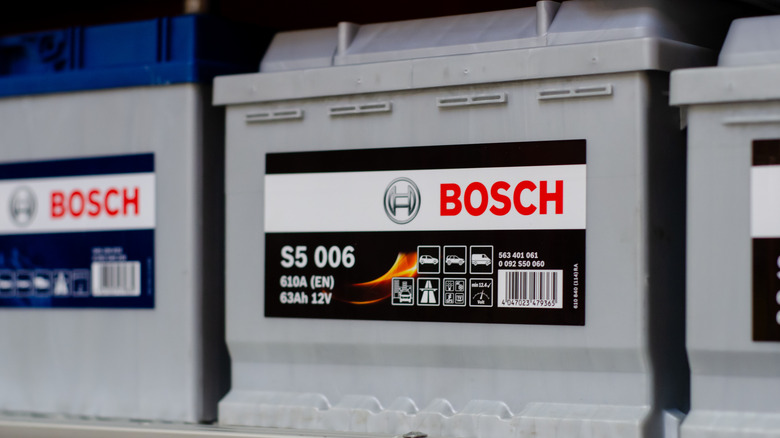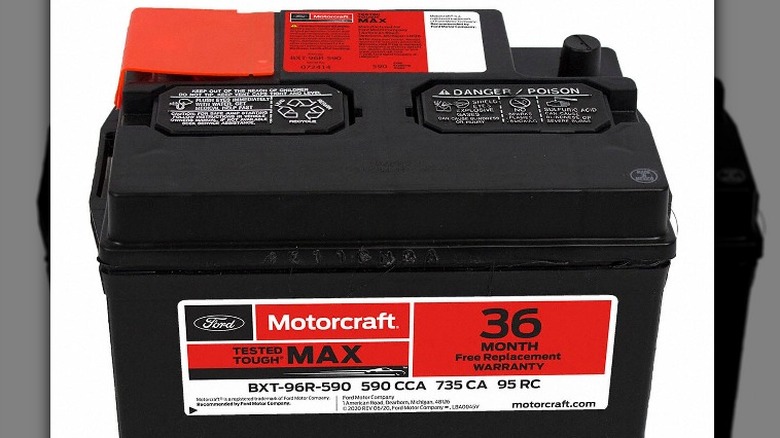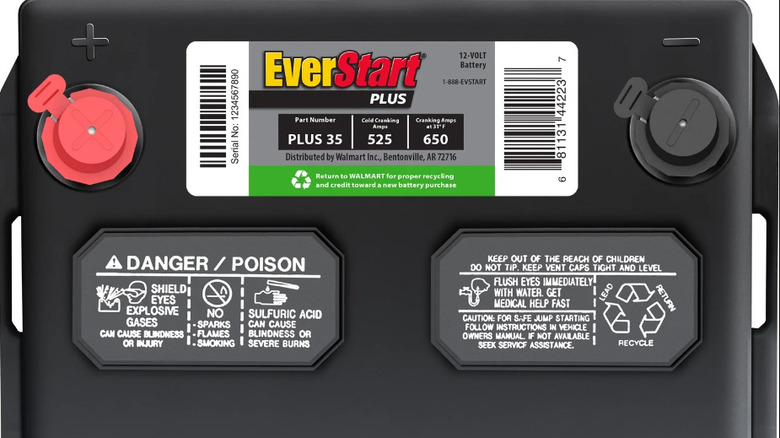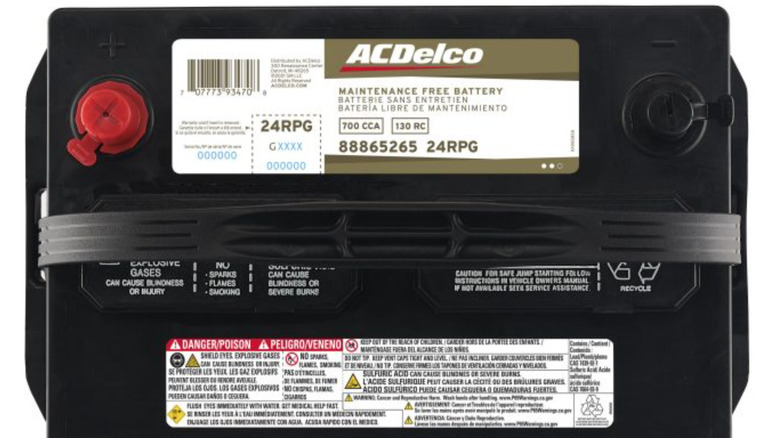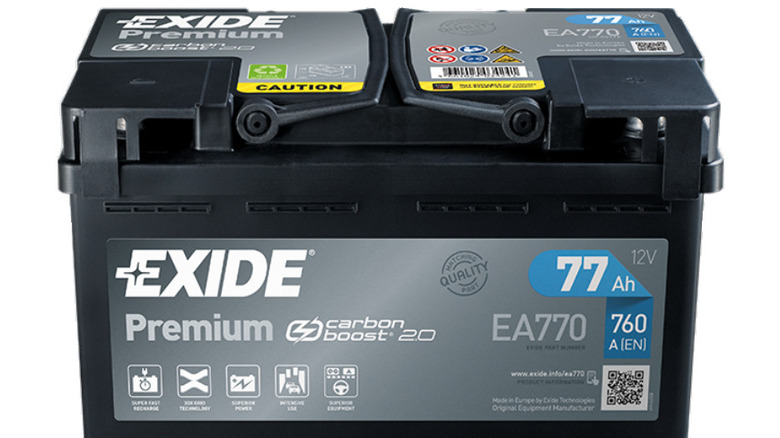What Do The Letters On Car Batteries Mean?
We may receive a commission on purchases made from links.
Most owners of gas- and diesel-powered vehicles don't spend a lot of time thinking about car batteries until it's time to get a new one. After all, modern batteries need very little maintenance. How do you even know when you need to replace your car battery? Sometimes it's obvious: the car won't start without a jump. That's when, suddenly, thoughts turn to car batteries.
It's easy enough have a shop or an auto club like AAA swap out the battery. But if you want to save some money or try a new brand, it's important to know what kind of battery the vehicle uses. You can get that information from your vehicle's user manual, or by reading the labels on your current battery.
That's what the letter and number codes can tell you. They include performance and longevity information such as amperage, manufacture date, and physical size, the way AAA or AA describes the size and voltage of small, flashlight-type batteries. (What the secret codes on your battery's label won't tell you, of course, is which are the best batteries and which ones to avoid. That's what you'll learn in our ranking of major car battery brands.)
Group size helps ensure the right fit
Battery shopping for the first time can be intimidating. Car batteries aren't universal — not every battery will fit every vehicle. Even a battery with the correct voltage may not sit in a car's battery tray correctly or have its terminals in the correct place to attach cables. It's important to know the group size for the vehicle.
Group size is a code on the label that includes numbers, or numbers and letters, representing measurement of the battery's physical dimensions. The group size also tells you voltage and terminal arrangement. The Battery Council International (BCI) created a group size classification system that auto manufacturers, aftermarket battery manufacturers, and sellers use. These group sizes are represented by a code of two numbers, or two numbers and a letter, and can be looked up in a chart for easy identification. For example, a common battery size for passenger cars is 94R, where the positive terminal is on the right side.
These standards are common in North America. Other parts of the world classify group size and battery performance differently, including European Norm (EN) in Europe, Deutsches Institut für Normung (DIN) in Germany, and Japanese Industrial Standard (JIS) in Asia. Many battery codes in one system have a corresponding code in another, if the batteries are equivalent. Auto parts stores and repair shops often have charts of battery equivalents from the main classification systems.
Cranking amps and cold cranking amps
The terms cranking amps (CA) and cold cranking amps (CCA) are ways of describing a battery's ability to start a car under specific conditions. CA and CCA appear next to numbers on a battery's label. The numbers help shoppers choose the best battery for a vehicle and the driving conditions it will face.
The number of cranking amps tells you how many amps a new battery can deliver for 30 seconds at full charge in 32-degree weather — with the terminal voltage staying at or above 1.20 volts/cell. The cold cranking amps number is derived from testing at 0 degrees for 30 seconds, with voltage staying at or above 1.20 volts/cell. Again, this number applies to a new battery on a full charge.
Shoppers looking for a battery to deliver a high enough number of amps to hold a charge in cold climates should look for a higher CCA number. Vehicles in Southern states where it's warmer, for example, could operate well with batteries that have lower CCA numbers.
Why are cold temperatures used to determine the cranking amps number? The internal chemical reaction that gives a battery its power will slow down as it gets colder around the car and its battery. A battery can pump out 100% of its power rating at 80 degrees Fahrenheit. But at freezing, that drops to 65% of its rating – which falls to 40% when the thermometer hits zero.
Amp hours and reserve capacity
The amp hours rating on a label tells how much energy a battery can deliver through 20 straight hours of use at 80 degrees, until voltage drops to 10.5V. A rating of 100 Ah means that in an ideal world, the battery will deliver 5 amps per hour in this 20-hour test. A higher amp-hour number means the battery can be used longer before it needs recharging.
The importance of the reserve capacity number is that it tells you how many minutes of power at a pre-determined load that the battery could, ideally, deliver from a full charge until its voltage falls. This number relates to the battery discharging without alternator recharge. This is relevant in cases such as when the electrical system isn't working correctly, and you want to know how long you can drive on the battery to reach a repair station.
It's also a useful number for estimating how long you could run accessories like radio and lights with power being drawn straight from the battery when the engine is off. Drivers who use heating, air conditioning, infotainment screens, or plug-in accessories in the outlets — with the engine off — should consider a battery with a higher reserve capacity.
Manufacture date and purchase date
Batteries, unlike fine wines, don't get better with age. It's good to keep track of a vehicle battery's age for warranty reasons and to anticipate when a new one will be needed, since a typical battery might last three to five years. Date labels on the battery can tell you whether your battery has lived past its warranty, or whether its replacement will be covered by the warranty if your battery has died prematurely.
The purchase date is typically printed on a rectangular label on the top. The label commonly has two rows of ovals with letters in the top row of shapes and numbers in the bottom row. The letters are abbreviations of month names, and the numbers represent years. When the battery is purchased, the corresponding month and year codes will be marked. For example, the code MY 24 would mean May 2024.
The manufacture date can be heat-stamped into the side or top of the battery, or it might just be a round sticker. This date, too, is represented by month and year — usually in numbers instead of letters for the sticker, and a combination of both for the heat stamp, with letters A through M representing the months, in order (with no letter I). Now that you know how to do it, it might be good to read how old your battery is so you have an idea of when you might need to buy a new one.
